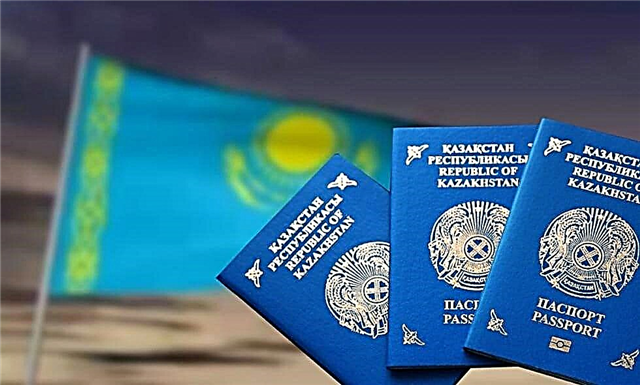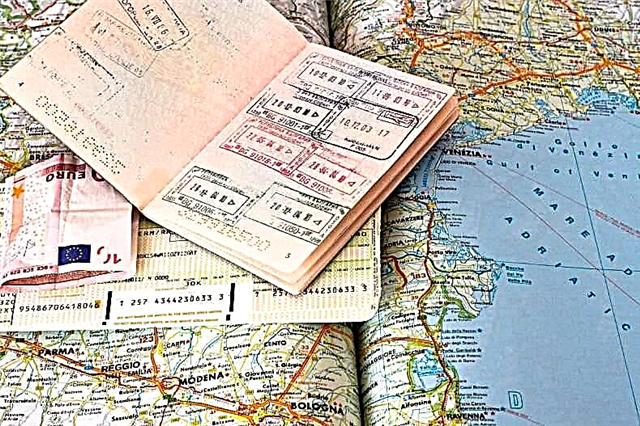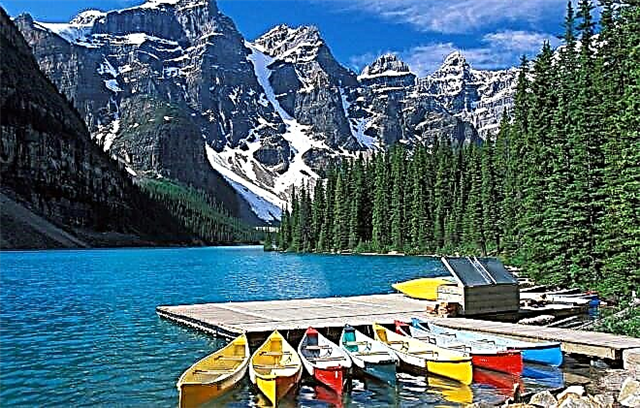Canada stretches across almost the entire continental latitude of North America and has maritime boundaries in three oceans: the Arctic, Pacific and Atlantic. The country's considerable length, variety of topographic features, and vast coastline have an impact on the climate of Canada. A vast part of the territory is located in a temperate climatic zone, and there are five of them in the country.
Briefly about the peculiarities of climatic zones
The weather on the east coast is affected by the impact of continental and Atlantic air fronts. The influence of the temperate maritime climate with frequent changes in atmospheric pressure and precipitation is felt.
The proximity of the Arctic Ocean and the dominance of the subarctic belt affect the temperature indicators in the north of the country, where –30… –35 ° С are usual in winter.

The islands of the Canadian Arctic Archipelago lie in the arctic zone with severe weather, winter temperatures there are approaching -45 ° C.
The Pacific coast in the west is influenced by a warm current, which leads to mild winters (+ 4 ° С) and comfortable summer weather (+ 20 ° С). Thanks to the Rocky Mountains, the climate of the Canadian provinces in the center - the prairies - is characterized by a predominance of moderate climatic conditions with precipitation in the summer season and a temperature of + 25 ° C.
Only in the southwestern part, closer to Vancouver, even in winter, there are no temperatures below zero. The subtropical marine climate provides this area with high rainfall and warm summers all year round.
Let's figure out what the climate is in Canada at different times of the year.
Snowy winter
Snowy winter begins throughout the country in November. Therefore, –3… –6 ° С during the day and –8… –10 ° С at night for December are typical temperature indicators. Snow cover averages 50 mm, with the exception of Vancouver, where the maximum precipitation occurs in the winter months - 180 mm. The thermometer readings of this city do not cross the zero mark - it rains there in winter.
January is the peak of cold weather. By region, the conditions are different: if for the south of the country the norm is + 4 ° С at night and + 6 ° С during the day, then in the territories of the Great Lakes and coastal regions the night temperature is –11 ° С, and the daytime –9 ° С.
The coldest city in Canada with an average annual temperature of -12 ° C is Snage, located in the Yukon province. In 1947, a record -63 ° C was recorded there in winter.
In February it is also snowy and frosty. For the southernmost city - Toronto - the usual air temperature is –2 ° С, while in Ottawa it will be a couple of degrees colder, and in the north –30 ° С and lower.
The daily average temperature in Canada in winter by months is shown in the table.
| Month / city | Quebec | Ottawa | Toronto | Calgary | Vancouver |
|---|---|---|---|---|---|
| December | -6 | -4 | +2 | -1 | +6 |
| January | -10 | -6 | -3 | -3 | +6 |
| February | -8 | -5 | -2 | +0 | +8 |
Short spring time
The arrival of spring is felt with the onset of April, and in March only a slight increase in daytime temperature indicators is observed, which contributes to the beginning of the melting of the snow cover.
Average temperatures in March are typically + 2 ° С during the day and –7 ° С at night. But the April weather makes significant adjustments, which is indicative of the daily temperature drops of 10 degrees.
In most of the country, no more than 4 rainy days are recorded with a precipitation level of about 40 mm, with the exception of the east, where they fall up to 80 mm.
Primroses appear in April, and the mass appearance of greenery occurs at the very end of the month and May. Vancouver, Ottawa and Montreal in May days are the most tempting for walks: the temperature during the day is + 16 ... + 19 ° С. In the central part of the country during the day at this time no more than + 15 ° С.
An idea of what Canada's climate is by months in spring can be obtained from the table:
| Month / city | Quebec | Ottawa | Toronto | Calgary | Vancouver |
|---|---|---|---|---|---|
| March | -3 | +2 | +2 | +4 | +10 |
| April | +5 | +11 | +8 | +11 | +13 |
| May | +16 | +19 | +17 | +15 | +16 |
Take a sociological survey!
[yop_poll id = ”9 ″]
About the delights of the summer season
With the onset of summer, and this is more likely the middle of June, comfortable weather sets in. The nights are already quite warm + 10 ... + 15 ° С, and in the daytime the air warms up to + 20 ... + 23 ° С. Even indicators of the temperature of coastal waters reach + 19 ° С.
Several rainy days of the month bring with them up to approximately 90 mm of precipitation. Canada in the summer is very attractive for tourism, especially sightseeing.
Although temperatures rise throughout the country in July-August is noticeable, there is no need to talk about heat, but rather about warmth. Only in the south the air warms up to + 35 ° С. The water temperature on the shores of the Atlantic and Pacific Oceans does not exceed + 18 ° C on average. The temperature in shallow freshwater lakes is much higher - + 25 ° С.
Crystal clear waters and wonderful beaches await holidaymakers in the provinces of Quebec, Nova Scotia, on the coast of Ontario.
What can be the average temperature in Canada during the daytime of the summer tourist season, the table will tell you.
| Month / city | Quebec | Ottawa | Toronto | Calgary | Vancouver |
|---|---|---|---|---|---|
| June | +21 | +24 | +22 | +20 | +19 |
| July | +24 | +26 | +27 | +23 | +22 |
| August | +23 | +25 | +26 | +23 | +22 |
Autumn Festival
The autumn period is very unpredictable. September still reminds of the passing summer, but in the evenings and nights it is much cooler. During the day, the average temperature is + 20 ... + 21 ° С, a little warmer in the southern part of the country. At this time, off the coast of the Atlantic, the water maintains a temperature of + 21 ° C.
In Canada, an autumn cold snap is a matter of one night. Fragrant green outfits of vegetation transform before our eyes, giving way to autumn decorations of incredible colors. But everything does not last long - in the second half of October, leaf fall begins and rainy weather becomes more frequent.
By the end of the month, the rains are replaced by sleet, it becomes cold from the chilly wind. Already in November, almost everywhere the thermometers drop below zero, and in the mountains the temperature is –30 ° С. Wettest weather in October-November in the Vancouver region.
These tables will tell you what the daytime air temperature in Canada in the fall.
| Month / city | Quebec | Ottawa | Toronto | Calgary | Vancouver |
|---|---|---|---|---|---|
| September | +19 | +20 | +22 | +18 | +18 |
| October | +11 | +13 | +14 | +12 | +14 |
| November | +2 | +5 | +7 | +3 | +9 |
Regional climatic features
Considering the fact that the countries are geographically located in the same latitudes, the climate of Canada and Russia is very similar. Let's dwell a little on the weather conditions of individual regions.
In the northern part, sub-arctic and arctic sub-regions are distinguished. This is a huge territory with severe weather conditions, where winter reigns for six months.
In addition to greatly differing in the length of daylight hours, humidity and average temperatures in the north and south of the country, they also distinguish:
- the region of the Rocky Mountains;
- prairies (steppes);
- coasts - East and West;
- region of the Great Lakes.
Changes in weather conditions are well traced in the Canadian highlands of the Cordilleras. In the north of the highlands, coniferous forests prevail. As they move to the south, they are replaced by steppes (50 ° N), and the extreme south is covered with vegetation of the subtropics.
There are also unfavorable climatic features of Canada that tourists need to know about. These include tornadoes that often occur from May to September in a number of provinces: British Columbia, New Brunswick, Quebec, Ontario, Alberta.
A little about the tourist seasons
A characteristic feature for Canada is the beginning of the seasons, which are usually counted here from the 20th of the month. For example, summer tourist tours start on June 21st.
For recreation, not only a variety of excursions are organized, but also ecotourism expeditions.
Tourists are offered helicopter tours to Niagara Falls and trips to the Bay of Fundy. For fans of extreme adrenaline, climbing Mount Tor and parachuting from its granite peak will add.
Autumn will delight you with many festivals.For ski lovers, the Whistler Blackcomb, Mont Tremblant and Banff ski resorts are open from November to March inclusive.
Admirers of the snowy winter are expected during the Christmas and New Year festivities. In winter, travelers also want to visit the Rideau waterfalls, which create bizarre ice sculptures, and admire the beauty of the northern lights in the mountains.
In spring, thousands of people come to Ottawa for the popular Tulip Festival.
Clothes for the trip: what to bring
Depending on the region and the purpose of the trip, it is necessary to properly assemble the wardrobe for the trip.
- Even in summer, knitted sweaters, pants and jeans will be more appropriate than light T-shirts and shorts.
- If you are planning a beach holiday, you will need swimwear. Don't forget about sweaters as it will be chilly in the evening without them.
- It is better to take with you a pair of shoes without heels and necessarily sneakers, which will be useful for any season (for the winter - insulated).
- For spring-autumn trips, you will need warm clothes: a jacket, pants and a hat. The weather is often cold and windy during the off-season.
- For a winter trip, get a down jacket and warm leather shoes with fur, and skiers should not forget about the appropriate equipment.
Do not fill your suitcases with unnecessary things. For flights to North America, the norm per person is no more than 2 pieces of baggage, 32 kg each. It is quite expensive to pay for the overweight.
Travel to protected places
Every year, the extraordinary beauty of Canada, preserved in its original state, attracts a huge number of tourists. Canadians are proud of their natural complexes and protect them carefully. Together with the Amazon, millions of hectares of Canadian forests form the largest lungs on the planet.
The uniqueness of Canada is also in the fact that its territory is simply strewn with fresh lakes (over 2 million) and the fresh water supply of this country is about 20% of the global one.
No wonder Canada is considered a record-breaking country that has managed to preserve the diversity and virginity of the natural human environment. Just for the sake of this, it is worth coming and looking at the pristine splendor.











